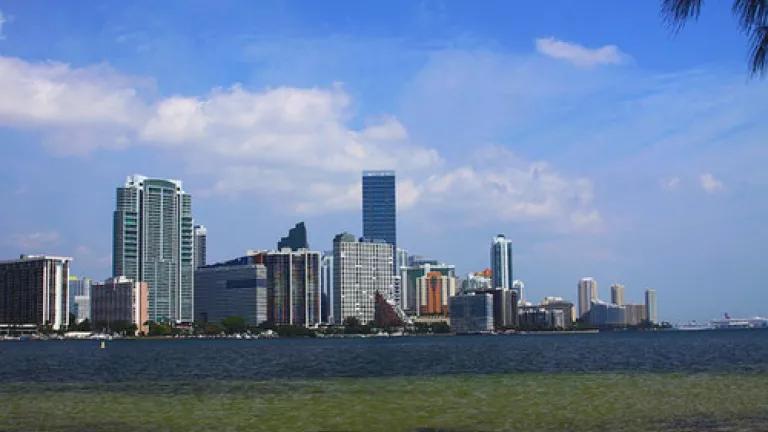
The EPA recently signed off on a $1.6 billion settlement to repair Miami-Dade County’s sewer infrastructure, including rebuilding the county’s oldest and largest sewage treatment plants. This is a settlement to EPA’s federal enforcement action to address Miami-Dade’s long record of harmful sewage discharges and repeated violations of the federal Clean Water Act.
But EPA’s settlement completely overlooks whether the proposed $1.6 billion in sewage infrastructure upgrades make sense given the future climate change challenges that Miami faces — like whether some of the sewage treatment plants will be underwater over the lifetime of their operation due to sea level rise or whether they could withstand expected hurricanes and storm surges. When spending this much money, one might want to make sure the investment will be around awhile.
Miami, Florida, is one of the most vulnerable cities in the United States when it comes to climate change. Here are just a few reasons why:
- Miami ranks first among the world’s port cities in terms of total assets at risk to a 100-year coastal flood event.
- By 2070, nearly 5 million people and $3.5 trillion in assets could be flooded by a 100-year coastal flood in the Miami area alone.
- Sea level rise of a little more than 2 feet would place nearly 70 percent of Miami-Dade County underwater at high tide.
So when President Obama says that a top priority is preparing our cities for the reality of climate impacts, you’d expect to see the EPA emphasize climate preparedness when it weighs in on how to fix Miami’s vulnerable sewer infrastructure.
But that’s not happening.
In June, President Obama laid out a bold vision for how our nation will begin to tackle the challenges associated with climate change, and he made climate change preparedness one of his administration’s top priorities.
The President’s plan proclaimed,
As we act to curb the greenhouse gas pollution that is driving climate change, we must also prepare for the impacts that are too late to avoid. Across America, states, cities, and communities are taking steps to protect themselves by updating building codes, adjusting the way they manage natural resources, investing in more resilient infrastructure, and planning for rapid recovery from damages that nonetheless occur.
Given Miami’s precarious relationship with our rapidly warming climate, he could have easily ended with, “And I’m talking to you Miami!”
The lawsuit brought by EPA against Miami-Dade County was accelerated by Biscayne Bay Waterkeeper’s notice of intent to file suit in October of 2012. Since then, Biscayne Bay Waterkeeper became a party to the federal action and has provided numerous expert reports and recommendations to advocate for a sewer system for Miami-Dade County that is built for the 21st century to withstand the challenges of sea level rise, erosion and storm surge.
But the proposed settlement, which requires huge investments for facilities with lifetimes measured in decades, fails to consider any of the risks of rising sea levels, hurricanes, extreme weather and climate-related catastrophes that are likely to occur during these facilities’ operational life. The settlement and consent decree still await final action by the federal district court in Miami
The consent decree issued by EPA and the Department of Justice focused on solutions to water pollution problems that have fouled Miami area waters for years. But EPA and the Department of Justice (DOJ) completely failed to consider whether those solutions make sense given the future climate change challenges that Miami faces — challenges that need to be factored in before investing in major sewer infrastructure projects.
Looking around the country few cities are at greater risk from climate-related catastrophes than Miami, as recently highlighted in an article that appeared in Rolling Stone. Built on low lying barrier islands and coastal marsh, this South Florida region of 5.5 million people would seem to be Exhibit A for the need to prepare for climate chaos.
But not in the eyes of EPA and Miami-Dade County officials, who ignored a request by Biscayne Bay Waterkeeper, along with NRDC and others, to integrate basic climate preparedness into any settlement over the construction and operation of Miami-Dade County’s sewage infrastructure.
EPA and DOJ’s inaction is a critical, missed opportunity to help climate-proof Miami. This is not only short-sighted, but is at odds with the President’s Climate Plan which states:
Agencies will also be directed to ensure that climate risk-management considerations are fully integrated into federal infrastructure and natural resource management planning.
This week, in comments submitted by Biscayne Bay Waterkeeper and by NRDC we highlight just how crucial it is for Miami to begin preparing for its climate future.
It’s important that the President’s Climate Action Plan be a real catalyst for climate preparedness. We cannot afford for federal agencies to simply disregard its objectives and its necessity. Cities and local governments need leadership, assistance, and (where necessary) prodding and encouragement by federal agencies. And citizens need to know that efforts are underway to protect their cities and make them resilient to climate-related disasters.
In this instance EPA must require solutions to the water pollution problems of the past and ensure that those solutions make sense for the climate of the future. There’s no excuse for further delay.

